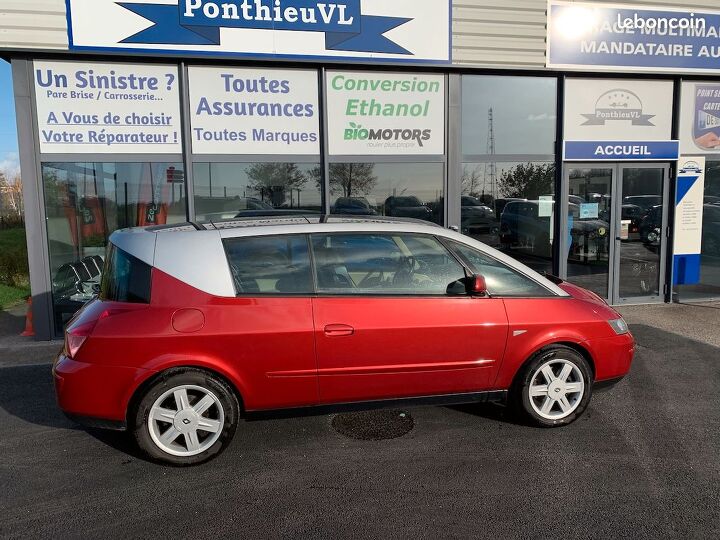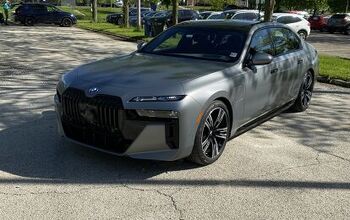Rare Rides: The Absolutely Epic 2002 Renault Avantime, a Big Sales Flop

Today’s Rare Ride is one of those that’s always been on the to-do list, but never floated to top of mind. That changed the other day, when this very tidy example was posted on Twitter.
Let’s talk about Privilege.
The Avantime was without predecessor at Renault, or really anywhere across the entire automotive landscape. This all-new type of car was part shooting brake, part van, part hardtop coupe, and part luxury greenhouse. The idea came not from Renault, but from the director of Matra, Philippe Guédon. He thought the descendants of Renault Espace owners (another Matra build) still felt a kinship to the modern, minivan incarnation of the family wagon. And as a result, younger buyers wanted and deserved a grand touring van-coupe. Given Matra was a longtime business partner with Renault, Mr. Guédon took his idea over there. Renault brass said “Let’s do it!” and Avantime was underway.
The project manager at Renault wanted the Avantime’s design to astound from every angle and pulled Patrick Le Quément to pen its shape. Innovative angles formed into an overall one-box design that lacked a b-pillar. For strength and lightness, Avantime’s structure and panels were made of aluminum. Special strengthened glass reflected heat and protected all four passengers inside the sumptuous luxury car interior filled with Bridge of Weir leather. In pleasant conditions, the glass roof and side windows retracted and allowed the desired open-air hardtop coupe van experience. Renault created a unique door hinge system for the Avantime: A double parallel setup which they called double kinematic. The hinges meant the large coupe doors opened wider for passengers to enter the car, but made a smaller horizontal motion. Useful in crowded parking lots.
Avantime shared components and a platform with the more down-to-earth Espace van, a suitable basis for the exciting new car. Power plants were borrowed from Espace as well and included 2.0- and 3.0-liter gasoline engines, and a 2.2-liter diesel. Transmissions were of five speeds if automatic, or six speeds if manual.
Project complete, Renault debuted Avantime at the Louvre in February 1999, where it had its own press conference. The Avantime (called Coupéspace at auto shows) went into production two years later and was built with pride by Matra. Renault introduced another luxury car at the same time in the more traditional Vel Satis, which unfortunately competed with the Avantime for sales. Time proved that customers chose neither Avantime nor Vel Satis, and went to other brands for their luxury coupe and sedan needs. As a result, in its debut year in 2001, Renault shifted just 772 Avantimes. Slow sales continued in 2002 and 2003, at which point Matra went bankrupt after hemorrhaging far too many Avantime-related Euros. Rather than move production to a Renault facility, Renault decided it was easiest to drop the Avantime. Just 8,083 examples were produced before the very unique van slipped from consumer memory, taking with it Matra’s 40-year car building legacy.
Today’s Avantime is in top-spec Privilege trim. It has a V6 engine, manual transmission, and a black leather interior with seats that look fairly Volvo-esque. Yours for $12,000, but it’s only importable by a Canadian at the moment.
[Images: seller; Renault]

Interested in lots of cars and their various historical contexts. Started writing articles for TTAC in late 2016, when my first posts were QOTDs. From there I started a few new series like Rare Rides, Buy/Drive/Burn, Abandoned History, and most recently Rare Rides Icons. Operating from a home base in Cincinnati, Ohio, a relative auto journalist dead zone. Many of my articles are prompted by something I'll see on social media that sparks my interest and causes me to research. Finding articles and information from the early days of the internet and beyond that covers the little details lost to time: trim packages, color and wheel choices, interior fabrics. Beyond those, I'm fascinated by automotive industry experiments, both failures and successes. Lately I've taken an interest in AI, and generating "what if" type images for car models long dead. Reincarnating a modern Toyota Paseo, Lincoln Mark IX, or Isuzu Trooper through a text prompt is fun. Fun to post them on Twitter too, and watch people overreact. To that end, the social media I use most is Twitter, @CoreyLewis86. I also contribute pieces for Forbes Wheels and Forbes Home.
More by Corey Lewis
Latest Car Reviews
Read moreLatest Product Reviews
Read moreRecent Comments
- Carrera 2014 Toyota Corolla with 192,000 miles bought new. Oil changes every 5,000 miles, 1 coolant flush, and a bunch of air filters and in cabin air filters, and wipers. On my 4th set of tires.Original brake pads ( manual transmission), original spark plugs. Nothing else...it's a Toyota. Did most of oil changes either free at Toyota or myself. Also 3 batteries.2022 Acura TLX A-Spec AWD 13,000 miles now but bought new.Two oil changes...2006 Hyundai Elantra gifted from a colleague with 318,000 when I got it, and 335,000 now. It needed some TLC. A set of cheap Chinese tires ($275), AC compressor, evaporator, expansion valve package ( $290) , two TYC headlights $120, one battery ( $95), two oil changes, air filters, Denso alternator ( $185), coolant, and labor for AC job ( $200).
- Mike-NB2 This is a mostly uninformed vote, but I'll go with the Mazda 3 too.I haven't driven a new Civic, so I can't say anything about it, but two weeks ago I had a 2023 Corolla as a rental. While I can understand why so many people buy these, I was surprised at how bad the CVT is. Many rentals I've driven have a CVT and while I know it has one and can tell, they aren't usually too bad. I'd never own a car with a CVT, but I can live with one as a rental. But the Corolla's CVT was terrible. It was like it screamed "CVT!" the whole time. On the highway with cruise control on, I could feel it adjusting to track the set speed. Passing on the highway (two-lane) was risky. The engine isn't under-powered, but the CVT makes it seem that way.A minor complaint is about the steering. It's waaaay over-assisted. At low speeds, it's like a 70s LTD with one-finger effort. Maybe that's deliberate though, given the Corolla's demographic.
- Mike-NB2 2019 Ranger - 30,000 miles / 50,000 km. Nothing but oil changes. Original tires are being replaced a week from Wednesday. (Not all that mileage is on the original A/S tires. I put dedicated winter rims/tires on it every winter.)2024 - Golf R - 1700 miles / 2800 km. Not really broken in yet. Nothing but gas in the tank.
- SaulTigh I've got a 2014 F150 with 87K on the clock and have spent exactly $4,180.77 in maintenance and repairs in that time. That's pretty hard to beat.Hard to say on my 2019 Mercedes, because I prepaid for three years of service (B,A,B) and am getting the last of those at the end of the month. Did just drop $1,700 on new Michelins for it at Tire Rack. Tires for the F150 late last year were under $700, so I'd say the Benz is roughly 2 to 3 times as pricy for anything over the Ford.I have the F150 serviced at a large independent shop, the Benz at the dealership.
- Bike Rather have a union negotiating my pay rises with inflation at the moment.






































Comments
Join the conversation
I just tripped over the YouTube vids from legendary designer Frank Stephenson; the Renault Avantime is covered in this episode, starting about 4 minutes in: https://www.youtube.com/watch?v=zCzDed7XoNY
A modern-day version of the Renault Le Car (a.k.a. Le Box).